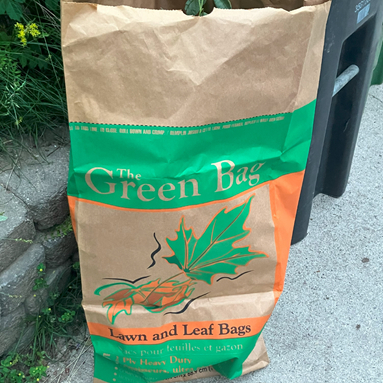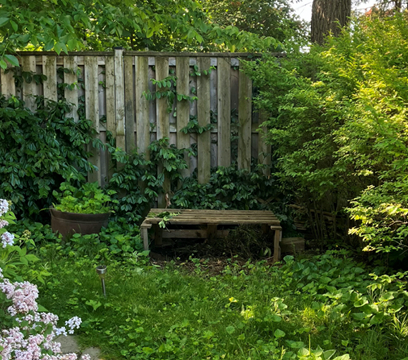
Home >> Newsletters > GreenFriends Newsletters > Q2 2024 Newsletter
| Home | Source Reduction | Friends of Green Friends | Newsletters |
| Gardening | Resources | What You Can Do | Embracing The Trees |
| Beauty in a Backyard Compost | ||||
| A few years ago, we were blessed with the opportunity to move out of our 16th floor apartment, into a house. Almost right away, my husband started talking about building a backyard compost.
"Is that really necessary?" I asked. "We have city compost." We live in Toronto where the city has us sort our garbage into recyclables, compost, and trash. Because they use large-scale anaerobic digestion technology, the city can compost things we can’t, like soiled pizza boxes, paper muffin wrappers, or corn cobs – for non-vegetarians, even meat scraps, eggs, or dairy products can go in the city compost! Once a week, food waste gets picked up from every house in the city, and processed into a nutrient-rich compost, which is then freely distributed to residents to use in their gardens. Food waste is also used by the city to generate renewable natural gas that gets used to power city vehicles and heat buildings. |
||||
 Garbage bin and green waste bin at the curb for pickup |
||||
|
I reasoned that since we benefit from the city program by picking up bags of compost every year, and it’s so convenient, couldn’t we just participate by leaving our food waste at the curb? Besides, we definitely didn’t want to attract mice or rats into the yard to feast on our food scraps. In previous years, we used a homemade compost system on our balcony, where there was no possibility of attracting vermin. It was an excellent solution to our building’s choice not to participate in the city compost program. But this system would no longer work in the house, if we wanted to avoid bringing in rodents. To continue composting our food scraps, we would need a large/solid backyard compost bin, and that was more plastic than either of us wanted to use. We don’t produce a lot of food waste in our household, and there would still be a few items that a backyard compost couldn’t handle, meaning we would need to rely on the city’s pickup system anyway. After much thought, we both conceded that using the city’s compost program was likely the most environmentally sound decision for dealing with our food waste. I was inwardly glad we didn’t have to dedicate any yard space to creating a compost system. My husband, though, didn’t give up on the idea of having our own compost. "What about composting our yard waste"? he asked. Somewhat dismayed, I responded that the city conveniently picks that up for us too. We just have to package it and leave it at the curb; it’s easy and free. He responded that although a good system, it still generates waste, because the yard waste (sticks, leaves, weeds, plant material, etc.) goes in bags. "But they’re paper," I said, ever conscious of our plastic footprint. "Paper still comes from trees," my husband stated softly. I was convinced. Reluctantly so. I wasn’t keen on using yard space for what I envisioned would be a huge eye sore. Nonetheless, I was on board with setting up a homemade yard waste composter. |
||||
 Neighbors' yard waste bag along the street |
||||
| Top Amma teaches us to reduce waste and minimize our impact on nature. I want to follow Amma’s words to the best of my ability. I certainly couldn’t let something as trivial as aesthetics stand in the way of reducing our paper bag consumption and doing our part for Mother Nature. I was skeptical at every stage of the project, but with humility and gratitude, I am now happy to say: I was wrong. We started by digging a large pit in the ground, about 20” x 40” and 1.5 feet deep at the front (the dirt floor of the pit is on a slant for ease of use). We reinforced the sides of the pit with recycled wood beams. The stakes used in the four corners, which hold the structure in place, were protected with asphalt glue so that they wouldn’t decompose in the ground. We found a wooden pallet that had been damaged and was put out with the trash on garbage day. We carried it home and modified it into a lid for the compost pit. A neighbor had torn down an old fence, and offered the wood pieces. The pallet and the fence became the walls and lid of the compost, which now stands about a foot above the ground. The front is open so yard waste can be easily tossed in, or the pit can be easily accessed. |
||||
 Digging the pit |
||||
| The whole system blends into the background so it’s barely even noticeable. In fact, when you notice it, it even looks nice.
We feed it with yard waste. Grass clippings when we mow the lawn, leaves that fall from the trees, plant clippings. Anything that looks too big, we snip into smaller pieces before tossing it in. (Some things we still leave to the city, which can handle larger items like sticks or complicated items like dandelions and other weeds.) Our compost system requires maintenance. When outdoor temperatures are above 50°F (10°C), we rotate it with a pitchfork to bring oxygen inside. This is done just once a week. Any unpleasant smell is a sign it’s not being rotated often enough. But that’s all it needs, and Mother Nature takes care of the rest. With time (about a year), the pile of yard waste decomposes into useable soil, which we can filter out by shoveling it into a container covered with a homemade chicken wire sieve. There’s nothing in there that attracts rodents or other animals. It doesn’t smell. It doesn’t even look offensive. |
||||
|
||||
|
Three years in, the yard waste compost is still a success. It is producing rich soil from decomposed plant matter that is immediately recycled into our backyard ecosystem. It feeds our vegetable garden and flowerpots. It connects us more deeply to the nature in our small outdoor space. What we give to nature pales in comparison to what she gives back. Our backyard compost is just one example of this. "It is high time to give serious thought to protecting nature. The destruction of nature is synonymous to the destruction of humanity. Trees, animals, birds, plants, forests, mountains, lakes and rivers - everything that exists in nature - is in desperate need of our kindness, compassionate care and protection. If we protect them, they will in turn protect us." - Amma Composting is an excellent way to support nature. When we put food waste into garbage and landfill, it creates harmful greenhouse gases, but when we manage food waste effectively, it can be turned into renewable energy and nourishing soil for plants. |
||||
 Compost pit blending into the yard in summer |
||||
|
There are lots of options for composting – from worms, to industrial/city solutions, to balcony or backyard options. The possibilities are there for all of us to contribute to a better world through waste management. "Every small effort we make towards environmental conservation is precious because it helps sustain life. This is actually more precious than any kind of material wealth." - Amma Natasha, Toronto ON |
Read Nature Offers Us the Most Precious Gift of Life in the Q2 2024 Newsletter >>
| Home | Source Reduction | Friends of Green Friends | Newsletters | Resources | What You Can Do | Embracing The Trees |
For more information, e-mail info@greenfriendsna.org |
||||||

